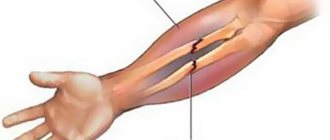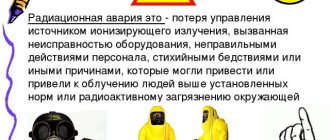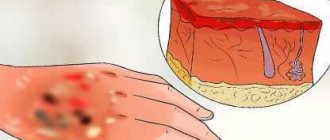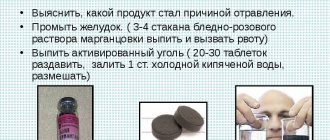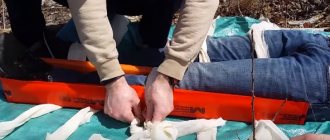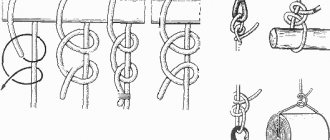Snow, ice and gusty winds - real winter has come to Moscow. Last night the temperature in the city dropped to minus 12–14 degrees. During the day, the thermometer will show eight to ten degrees below zero.
From the middle of the week the frosts will subside, but the temperature will remain several degrees below normal. In such weather there is a high risk of hypothermia and frostbite. Hypothermia can cause both local and general cold injury, and deep frostbite can lead to disability.
Frostbite: main risks
Most often, the feet suffer from cold, followed by the hands, followed by the nose, ears and cheeks. The body loses heat faster in cold water, or if a person is wearing wet clothes or shoes. The risk of frostbite is higher in strong winds and snowstorms, as well as in those who wear tight shoes or do not change body position for a long time. Vascular diseases, neuritis, previous frostbite, fatigue, exhaustion, hunger, and past infectious diseases also contribute to cold injury. People often get frostbite while intoxicated.
Degrees and signs of frostbite
Depending on the duration and intensity of aggressive exposure, as well as on the nature of tissue damage, 4 degrees of frostbite are distinguished.
The initial manifestations are similar in all cases (which does not allow us to reliably determine the degree of frostbite in the first hours after the injury):
- pale and cold skin;
- decreased sensitivity.
After the appearance of the first general symptoms, symptoms specific to each degree of frostbite develop:
- It is characterized by mild soreness of the skin; after warming, intense redness and slight swelling are noted; peeling of the affected areas is possible without the development of necrosis. After 5-7 days, skin manifestations completely disappear.
- Within 24-48 hours, blisters of various sizes appear on damaged areas of the skin, filled with transparent (serous) contents. The pain is intense, characterized by itching and burning of the injured skin. With proper treatment, the skin condition is restored within 7-14 days, and there are no scar deformities at the site of the lesion.
- Necrosis of the damaged skin occurs, which leads to loss of sensitivity and the formation, after warming, of massive painful blisters with a purplish-bluish base, filled with bloody contents. Subsequently, the blisters necrotize and are rejected with the formation of scars and granulations. Scarring can last up to a month, and rejection of the nail plates also occurs, sometimes irreversibly.
- It manifests itself as total necrosis of not only the skin, but also the underlying soft tissues (up to the bones and joints). The injured areas of the skin are cyanotic, after warming a sharply increasing swelling forms, there are no blisters, the sensitivity of the skin is not restored after warming, and gangrene subsequently develops. The affected areas are subject to amputation.
With prolonged exposure to low temperatures, general hypothermia is possible, as evidenced by a decrease in body temperature to 34 ºC or lower (up to 29-30 ºC in severe cases). Depending on the severity, the condition manifests itself as depression of the respiratory, cardiovascular and nervous systems of varying intensity, up to coma and death.
What are the signs of frostbite?
The first signs of frostbite are easy to miss. The skin temperature drops, it becomes pale, loses sensitivity, but a tingling or burning sensation may be felt. While a person is in the cold, it is very difficult to determine the extent of damage. It is determined after warming.
If the skin becomes warmer when warmed, and sensitivity is restored, this means that the cold injury is superficial. Pain and lack of sensitivity are characteristic of deep frostbite.
Based on the depth of injury, injuries are divided into four types. The first two are classified as superficial, the rest - deep. First degree frostbite affects the superficial layers of the skin. After warming up, pale skin may turn red or even become bluish, and after a while it may peel off. Within a week her condition returns to normal.
With a second-degree injury, blisters filled with fluid, most often light, form on the skin. After about a week they subside, and after another two to three weeks the skin is completely restored.
In the third degree, the blisters are often filled with pink or red liquid, and their bottom is blue-purple. After the dead tissue is sloughed off, wounds are formed. With the fourth degree of frostbite, the affected part of the body swells sharply, becomes dark, and gangrene may develop.
What to do is strictly not recommended
In no case:
- Do not rub snow on the affected areas , this will damage the blood vessels. As a result of such actions, abrasions appear on the skin, through which infection can penetrate. In addition, this procedure will not warm you up, but, on the contrary, will cool you down even more.
- Do not use a hot shower, bath, heating pads , or fire to warm up the victim. A sharp change in temperature will not allow blood circulation to be restored. This can lead to death of the affected skin areas.
- Do not lubricate the skin with ointment or fat - this will lead to injury and increase cooling.
- Do not give the person drinks containing alcohol or coffee . They sharply dilate blood vessels. This can lead to their rupture, and further to internal bleeding or impaired cardiac function.
- Do not pop any bubbles yourself.
- If there is a risk of recurrent frostbite, do not allow already affected areas of the body to thaw. If this has already happened, then wrap them up so that they do not freeze again.
Be sure to read:
Is treatment necessary for molluscum contagiosum in children?
First aid
The victim must be moved from the cold to a warm, windless place, take off wet clothes, and wrap him in a blanket. You can warm a frostbitten area using heat-insulating materials, for example, cotton-gauze bandages with a layer of compress paper or plastic film; if this is not at hand, use foam rubber, blankets, and so on.
A hot drink and a warm bath will help you warm up. It is necessary to heat the water in it gradually. They start with a temperature of plus 17–18 degrees and within about an hour the water is heated to plus 36–37 degrees.
But you shouldn’t rub frostbitten skin with ice and snow. There is a high risk of further hypothermia and injury.
Prohibited Methods
There are a number of mistakes that are often made when providing first aid for frostbite and hypothermia.
Let's consider the most dangerous and unnecessary actions for the health of the victim.
- Rubbing damaged areas with snow. Snow is a collection of tiny crystals, which, when rubbed, will cause even greater injury to frostbitten skin. And since it is always filled with dirt, infection will be added to the damage.
- Injury to frostbitten areas of the body. Any additional damage will lead to complications in the form of purulent discharge.
- Using ointments, lotions, alcohol and oils to rub the skin.
- Intense and rapid exposure to heat. In this case, the vessels cannot cope with the load, and the tissues die. Then only amputation can stop the spread of infection.
- Used to warm large quantities of alcoholic beverages when exposed to cold. The victim will not be able to warm up, and the amount of heat transfer will only increase.
When providing assistance, you need to remember that any actions related to the possibility of infection or damage to the integrity of skin tissue are prohibited.
Degrees and their symptoms
First aid for frostbite is provided according to the algorithm described above, regardless of the types and degrees of damage to tissues and nerve fibers. However, their knowledge is fundamentally important when prescribing appropriate therapy and choosing a treatment method.
Let us consider the types of tissue damage due to frostbite, based on the principles of their classifications.
First of all, the degree of tissue damage is determined. It is set based on how deep the cold has penetrated into the tissue.
Diagnosis is carried out in a hospital setting, where employees of a medical institution analyze the dynamics of restoration of the frostbitten area of the skin. Visual inspection and palpation can reveal the extent of the damage.
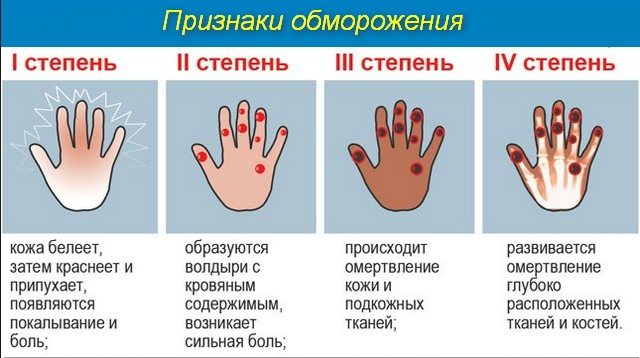
Doctors distinguish 4 degrees of frostbite. Let's consider their manifestations and methods of treatment.
- 1st degree.
Damage is recorded only on the most superficial layers of the skin.
Symptoms:
- When exposed to cold, the skin becomes pale marble in color;
- When warm, the skin turns red;
- There is a feeling of burning and heat;
- There is slight swelling;
- Slight decrease in sensitivity;
- The skin itches and begins to hurt;
- Small bubbles filled with clear liquid may form.
Therapy is aimed at restoring skin temperature and blood flow and preventing infection.
- 2nd degree.
The entire thickness of the skin is frostbitten, but the stem cells remain intact.
The appearance of large blisters is added to the signs of grade 1. They may contain blood.
- 3rd degree.
All skin tissue is damaged: dermis, fiber, stem cells.
Vivid symptoms begin to appear:
- The skin becomes bluish;
- There is no sensitivity;
- Extensive swelling appears;
- The frostbitten area of the body is very cold upon palpation.
This condition requires surgical excision of damaged tissue.
- 4th degree.
Prolonged exposure to cold leads to damage to all layers of skin tissue, reaching bones, tendons and muscles. The skin becomes blue-black and sensitivity completely disappears. When palpated, the victim does not experience pain, and when pierced, blood does not come to the surface. Immediately after warming, extensive tissue swelling quickly develops.
First aid for hypothermia of degrees 3 and 4 consists of immediate hospitalization of the victim with the application of a thermal insulating bandage.
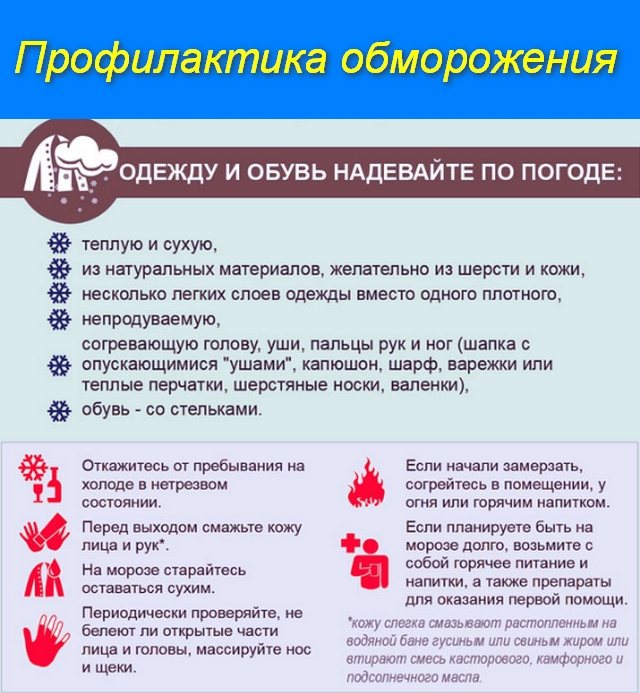
Stages and mechanisms of action
Hypothermia is characterized by three stages of development, depending on which emergency care for frostbite will have its own characteristics.
There are mild, moderate and severe stages of cold damage to the human body.
Mild frostbite requires only conservative treatment. This stage is characterized by the following symptoms:
- The skin is pale;
- Chills occur;
- The speech process becomes difficult;
- A reduced heart rate is recorded;
- Blood pressure and respiration levels are normal.
Assistance for mild stage hypothermia is carried out according to types 1 and 2 degrees of frostbite.
The middle stage is characterized by a sharp decrease in body temperature to 30 degrees.
The victim feels severe drowsiness and loss of strength, consciousness is depressed. Pulse and breathing slow down.
This condition can accompany all four degrees of frostbite, so assistance is provided depending on the symptoms.
In the severe stage, critically low body temperature and blood pressure are observed. The victim loses consciousness, convulsions are observed, and vomiting is possible. Damaged areas of the body are cold and acquire a pronounced bluish color. Breathing slows to three times per minute.
First aid for severe frostbite consists of immediate hospitalization followed by surgical intervention.
Prolonged exposure to low temperatures leads not only to frostbite, but also to a general cooling of the body. And when it becomes hypothermic, there is a decrease in the level of protective forces, which leads to colds and viral diseases.
Signs of hypothermia
Hypothermia is accompanied by a general depression of consciousness, up to coma; Muscle tremors may occur. A decrease in temperature below 30 degrees leads to the cessation of trembling and the appearance of muscle rigidity, reminiscent of rigor. There are three successive stages of development of general cold injury: mild, moderate and severe.
During the mild stage, the internal body temperature drops below 35 degrees. First, a person feels chills, breathing and pulse quicken, blood pressure rises slightly, and goose bumps appear. Then, due to a decrease in the temperature of the internal organs, their functions are inhibited: the frequency of breathing and heartbeat decreases, the person feels lethargy, apathy, drowsiness, and muscle weakness. Coordination of movement and vision may be impaired, and hallucinations may occur.
During the middle stage of frostbite, the temperature of the internal organs drops to about 30 degrees. The victim's skin turns pale (sometimes acquires a marble tint), the heart rate decreases, consciousness becomes confused, speech and movements are impaired, facial expressions are absent, reflexes are weakened, and stupor occurs.
In the severe stage, the temperature of the internal organs drops below 30 degrees, and all the basic vital functions of the body are inhibited. A person may experience cramps and increased muscle tone. It becomes difficult to straighten the arms and legs, the victim is unconscious, and reflexes weaken. A person’s heart rate and blood pressure decrease, breathing becomes less frequent; Possible urinary and fecal incontinence. With a further drop in temperature, imaginary death may occur, in which breathing, pulse and blood pressure are barely perceptible, and reflexes are not detected. If the core body temperature drops to 25–22 degrees, a person may die.
After the body warms up, a reactive period begins. As a rule, lethargy, fatigue, drowsiness, stiffness of movement, and headache are noted. In severe hypothermia, swelling of internal organs may develop: the brain, lungs and others. Thrombosis may occur, and cardiovascular activity may also be disrupted, acute renal failure and nervous system disorders may develop. Subsequently, inflammation of internal organs may appear: pneumonia, bronchitis, nephritis and others.
First aid for mild hypothermia
A mild degree of hypothermia is usually not accompanied by serious complications for the victim’s body, but only activates the sympathetic autonomic system, which tries to protect the body from the cold on its own by using basic and additional compensation mechanisms.
The lack of first aid can lead to a deterioration in the victim’s condition, worsening the degree of hypothermia, the appearance of local frostbite and other problems.
What should be done in case of hypothermia in the convulsive stage?
First aid for hypothermia includes the following:
- Eliminating contact with the cold - this must be done first in order to avoid worsening hypothermia; it is necessary to help the person get into a dry, heated and closed room so that external environmental factors no longer have a negative impact on the victim. After entering the premises, the patient is removed from all wet and cold clothes, including underwear, and then allowed to change into dry clothes;
- Warm drink. The victim must be given a warm liquid to drink, from 0.5 to 1 liter. This can be tea, compote, rich broth, the temperature of which does not exceed 50-55 degrees. The use of alcoholic beverages is prohibited due to their negative effects on the body - alcohol dilates blood vessels, which leads to an acceleration of the process of hypothermia;
- Warming massage. Hypothermated parts of the body must be carefully and thoroughly massaged, making translational and rotational movements with the palms of the victim’s skin. Just don’t overdo it - too much pressure can worsen the functioning of peripheral vessels and increase pain;
- Thermal insulation and bed rest. The patient should be wrapped in a thick cotton blanket and then put to bed for 10-12 hours. In cases where a child under 12 years of age or a person over 50 has suffered from hypothermia, it is advisable to call home a pediatrician or therapist, respectively, who will examine the victim and, if necessary, give his own recommendations for further home or outpatient treatment.
First aid for hypothermia
The victim needs to be helped to restore normal body temperature. The simplest and safest method is warm clothes, blankets and a warm room. It is very important to keep your head covered because it gives off 30 percent of the heat. Electrically heated blankets can be used. Only the chest needs to be warmed, otherwise complications may occur.
Hot drinks and a warm bath (heat gradually to a temperature no higher than plus 36 degrees) help. In the bath, you can gently rub your body with soft washcloths. With a mild degree of cooling, only warming is sufficient; with moderate and severe cooling, the victim needs medical attention.
Actions for moderate hypothermia
Moderate hypothermia in most cases carries certain risks for the victim’s body - more pronounced pathological symptoms are accompanied by the presence of many consequences that do not pose a direct threat to life, but are quite unpleasant and worsen the patient’s health.
Providing first aid for stuporous hypothermia:
- Immediately stop contact with cold . The person must be transported to a warm and dry room, cold or wet clothes are removed from him, after which the victim changes into warm and dry clothes. If there is no possibility of immediate transportation (for example, when you are far from populated areas), you need to call a team from the Ministry of Emergency Situations, make a fire and stay close to it (it is prohibited to warm yourself over an open flame);
- Warm drink and food . If the victim is conscious and the swallowing reflex is preserved, it is necessary to give the person warm drink and food. Their temperature should not exceed 50 degrees Celsius;
- Warming up . Classic warming massage in case of moderate hypothermia, as a rule, is not effective. If a person does not have frostbite of degree 2 or higher, then you can use a bath with water to solve this problem. The initial temperature of the liquid is about 30 degrees. The victim is immersed in warm water, after which the temperature is slowly raised (10 degrees per hour) to 40 degrees;
- Medicines . In pre-medical practice, antispasmodics (drotaverine, mebeverine, they can be administered only at the beginning of the warming process), painkillers (pain relief - analgin, ibuprofen), non-steroidal anti-inflammatory drugs (reducing the intensity of the emerging inflammatory process - ketorolac, aspirin, nimesulide), antihistamines are used. (reducing the body’s autoimmune response, counteracting potential shock - Zyrtec, loratadine, clemastine, suprastin), as well as shock doses of vitamins (mainly vitamin C, which protects and strengthens the walls of blood vessels);
- Thermal insulation . The victim should be wrapped in a thick cotton blanket. Separately, a special bandage made of layers of gauze and cotton wool is applied to the areas of local frostbite, with a splint on top of it;
- Call an ambulance . In case of moderate hypothermia, it is advisable not to wait for the therapist to arrive from the clinic, but to immediately call an ambulance - they will be able to assess the degree of risk of complications and, if necessary, transport the patient to the hospital for complex treatment.
Symptoms of hypothermia
Before providing first aid for hypothermia, you need to be able to distinguish the symptoms. Hypothermia is very easy to recognize by the following signs:
- Forgetfulness
- Severe chills
- Lethargy, drowsiness
- Confusion of speech
- Skin that is cold to the touch and pale in appearance
- Dyspnea
- Cardiopalmus
- Apathy towards everything that happens
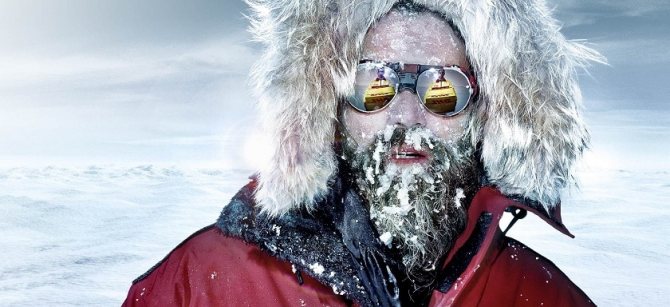
If, when the first signs of hypothermia appear, a person continues to be in the same environment, then other symptoms appear: cardiac arrhythmia, slow pulse, forgetfulness, shallow breathing, bluish skin, disorientation in space, severe trembling. At this stage, under no circumstances should you succumb to extreme drowsiness.
With severe hypothermia, frostbite also occurs, and the person’s condition becomes critical. Cardiac arrest, loss of consciousness, convulsions, nausea and vomiting occur, blood pressure becomes too low, normal brain activity is disrupted, and pupils enlarge.
How to prevent frostbite
Knowing the rules of first aid for frostbite is a necessary thing, but any doctor will tell you that prevention is better than cure. Therefore, it is worth following simple rules of prevention:
- warm weather-appropriate clothing in several layers is trivial, but many people neglect this;
- loose winter shoes without heels - tight boots compress the leg and impair its blood supply;
- using a scarf, hat, gloves - this way you can protect your face and hands from frost;
- refusal of metal jewelry, piercing of open parts of the body;
- giving up alcohol and smoking;
- high-calorie food;
- lubricating exposed skin with a rich cream.
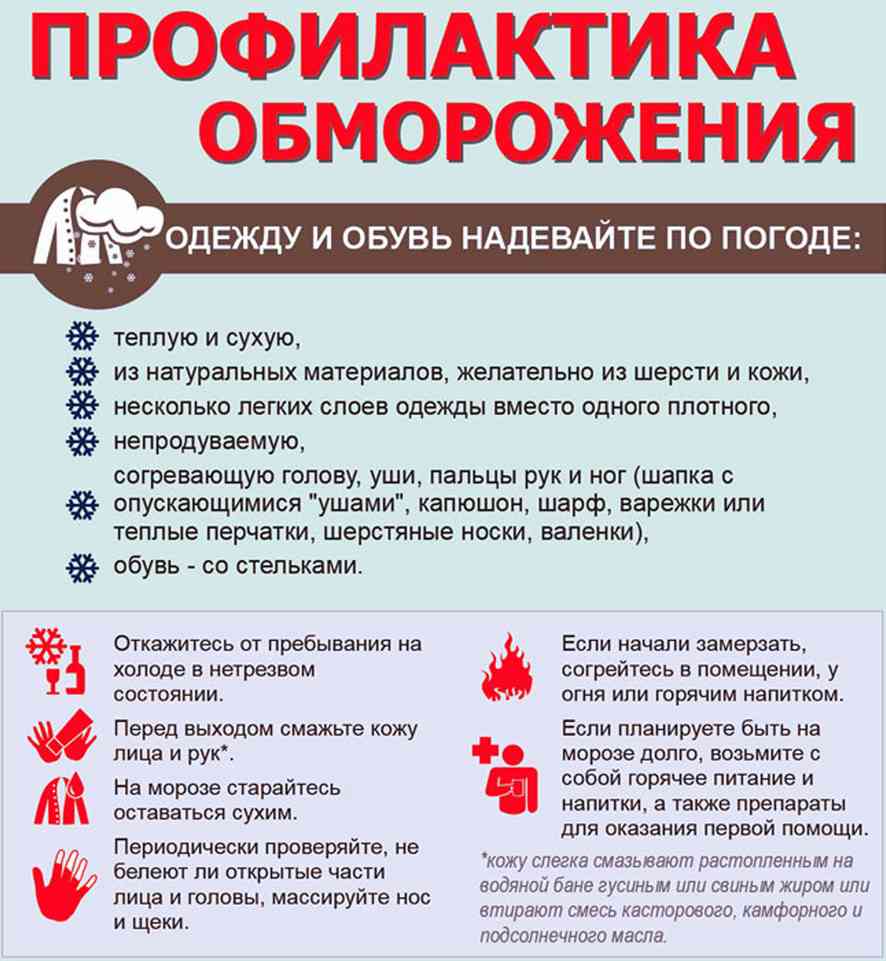
If you are too cold, go into any warm room (shop, cafe, entrance) and warm up.
And the simplest rule is that in severe frost, try not to go outside unless absolutely necessary.
Even if you are able to provide perfect first aid, it may not be enough. Therefore, anyone with frostbite should be taken to a medical facility. Specialists will be able to accurately determine the extent of damage and prescribe the most gentle and at the same time most effective treatment.
Bozbey Gennady Andreevich, emergency doctor
33, total, today
( 197 votes, average: 4.78 out of 5)
Osteochondritis dissecans of the hip joint
Scoliosis in adults and children: symptoms, causes, classification
